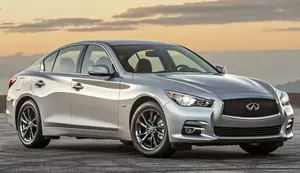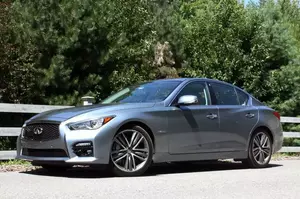
| Vehicle | Precise engine size | Difference from world average | Engine size to consumption ratio | Horsepower from 1 L | Engine size to 100 kg of weight |
|---|---|---|---|---|---|
| 3.5 |
3.5 L (3498 cc) |
49.1% bigger | 97 cc to 1 mpg | 87 hp from 1 L | 194 cc to 100 kg |
| 2.2d |
2.14 L (2143 cc) |
8.7% smaller | 41 cc to 1 mpg | 79 hp from 1 L | 134 cc to 100 kg |
| 2.0t |
1.99 L (1991 cc) |
15.1% smaller | 54 cc to 1 mpg | 106 hp from 1 L | 133 cc to 100 kg |
| S 3.0t |
1.99 L (1991 cc) |
15.1% smaller | 77 cc to 1 mpg | 204 hp from 1 L | 117 cc to 100 kg |
| 3.0t V6 |
3 L (2997 cc) |
27.7% bigger | 136 cc to 1 mpg | 100 hp from 1 L | - |
| Vehicle | 3.5 |
|---|---|
| Precise engine size | 3.5 L (3498 cc) |
| Difference from world average | 49.1 bigger |
| Engine size to consumption ratio | 97 cc to 1 mpg |
| Horsepower from 1 L | 87 hp from 1 L |
| Engine size to 100 kg of weight | 194 cc to 100 kg |
| Vehicle | 2.2d |
| Precise engine size | 2.14 L (2143 cc) |
| Difference from world average | 8.7 smaller |
| Engine size to consumption ratio | 41 cc to 1 mpg |
| Horsepower from 1 L | 79 hp from 1 L |
| Engine size to 100 kg of weight | 134 cc to 100 kg |
| Vehicle | 2.0t |
| Precise engine size | 1.99 L (1991 cc) |
| Difference from world average | 15.1 smaller |
| Engine size to consumption ratio | 54 cc to 1 mpg |
| Horsepower from 1 L | 106 hp from 1 L |
| Engine size to 100 kg of weight | 133 cc to 100 kg |
| Vehicle | S 3.0t |
| Precise engine size | 1.99 L (1991 cc) |
| Difference from world average | 15.1 smaller |
| Engine size to consumption ratio | 77 cc to 1 mpg |
| Horsepower from 1 L | 204 hp from 1 L |
| Engine size to 100 kg of weight | 117 cc to 100 kg |
| Vehicle | 3.0t V6 |
| Precise engine size | 3 L (2997 cc) |
| Difference from world average | 27.7 bigger |
| Engine size to consumption ratio | 136 cc to 1 mpg |
| Horsepower from 1 L | 100 hp from 1 L |
| Engine size to 100 kg of weight | - |

| Vehicle | Precise engine size | Difference from world average | Engine size to consumption ratio | Horsepower from 1 L | Engine size to 100 kg of weight |
|---|---|---|---|---|---|
| 2.0 |
1.99 L (1991 cc) |
15.1% smaller | 54 cc to 1 mpg | 106 hp from 1 L | 133 cc to 100 kg |
| S 3.0 V6 |
3 L (2997 cc) |
27.7% bigger | 115 cc to 1 mpg | 135 hp from 1 L | 176 cc to 100 kg |
| 2.2D |
2.14 L (2143 cc) |
8.7% smaller | 44 cc to 1 mpg | 79 hp from 1 L | 134 cc to 100 kg |
| S 3.5 V6 |
3.5 L (3498 cc) |
49.1% bigger | 100 cc to 1 mpg | 104 hp from 1 L | 184 cc to 100 kg |
| Vehicle | 2.0 |
|---|---|
| Precise engine size | 1.99 L (1991 cc) |
| Difference from world average | 15.1 smaller |
| Engine size to consumption ratio | 54 cc to 1 mpg |
| Horsepower from 1 L | 106 hp from 1 L |
| Engine size to 100 kg of weight | 133 cc to 100 kg |
| Vehicle | S 3.0 V6 |
| Precise engine size | 3 L (2997 cc) |
| Difference from world average | 27.7 bigger |
| Engine size to consumption ratio | 115 cc to 1 mpg |
| Horsepower from 1 L | 135 hp from 1 L |
| Engine size to 100 kg of weight | 176 cc to 100 kg |
| Vehicle | 2.2D |
| Precise engine size | 2.14 L (2143 cc) |
| Difference from world average | 8.7 smaller |
| Engine size to consumption ratio | 44 cc to 1 mpg |
| Horsepower from 1 L | 79 hp from 1 L |
| Engine size to 100 kg of weight | 134 cc to 100 kg |
| Vehicle | S 3.5 V6 |
| Precise engine size | 3.5 L (3498 cc) |
| Difference from world average | 49.1 bigger |
| Engine size to consumption ratio | 100 cc to 1 mpg |
| Horsepower from 1 L | 104 hp from 1 L |
| Engine size to 100 kg of weight | 184 cc to 100 kg |